Strengthening the Green Deal in Latvia: what could we expect from electrical mobility?
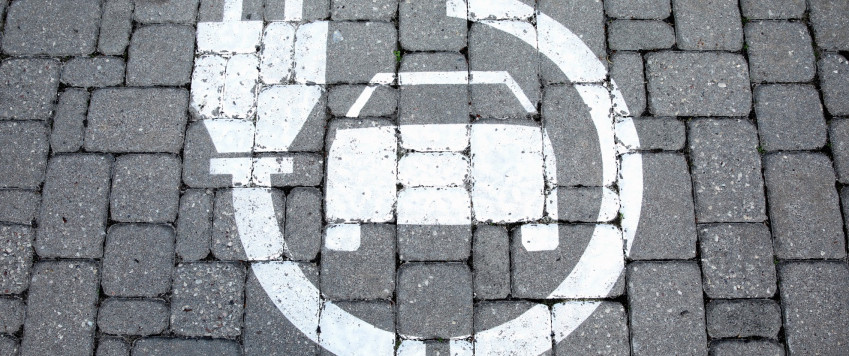
In Latvia, which has long been a catching-up economy, a few issues referring to greener practices might seem uncomfortable: people do not find it pleasant to realise that they are neither very well-off nor their lifestyle is green enough. At the same time, certain data allow for pointing the finger at those whose practices are less environmentally friendly.
However, this gives no reason to ignore the current relevance of sustainable practices or the objectives of climate neutrality to be achieved in the coming decades. Sustainable practices mitigate the risks of natural disasters, food shortages, mass migration and other risks, which would require an emergency response and involve high costs. Thus, the issue of sustainability is high on the agenda of economic policy makers, including central banks.
Over the most recent years, a number of proposals have been made as to how daily consumption can help people to yield the most rapid results on the path towards a more environmentally and health-friendly lifestyle. The transport sector is often cited as an important environmental pollutant that produces a significant volume of greenhouse gas (GHG) emissions. I do not intend to take a stand for or against electromobility in this article, but rather look at the expected contribution to greening.
Ambitious targets, frightening reasons
The sound produced by the "foghorn" of the Green Deal is intensifying and inviting people to pay attention to the impact of consumption habits on the living environment. Policy guidelines have been designed, document files are becoming more voluminous [1], and the scope of responsibilities towards humanity is expanding.
On the one hand, the European Union (EU) pursues ambitious targets of decoupling economic growth from the use of resources (by switching to a circular economy) and of ensuring climate neutrality by 2050. On the other hand, these targets are clear not only for the reasons already set out in the introductory part of the article but also when getting a glimpse of the World Health Organisation's data suggesting that seven million of the world's population dies as a result of air pollution every year [2] (although this figure is less than the eight million dying of smoking [2], it constitutes more than half of deaths induced by environmental factors [3]). Moreover, this is, in fact, the real situation rather than the bugbear waiting for us at some point in the future when the rise in average air temperature by certain degrees will extend the Earth's territory uninhabitable.
Remote work and... a sedentary lifestyle are the most conspicuous aspects related to Covid-19. We will be left in the dark for a while before discovering how much of this will take root in the post-crisis world. Remote conferences and meetings will possibly continue to play an important role in reducing people's mobility needs (they will be, however, complemented by other needs, e.g. energy for digital solutions). In terms of GHG emissions, the charts below show that the transport sector is a significant source of air pollution. Meanwhile, a modern and environmentally-friendly mobility, including electromobility, is an option to live differently in the future.
Can much be achieved by greening the transport sector?
The European Parliament defines electromobility as the use of vehicles that are powered by one or more electric motors for propulsion [4]. Development of electromobility is driven by logical reasons. First, the transport sector is one of the major sources of GHG emissions in European countries, including Latvia (see Chart 1).
Chart 1. Overall volume of GHG emissions (kg/per capita per year) in European countries in 2019
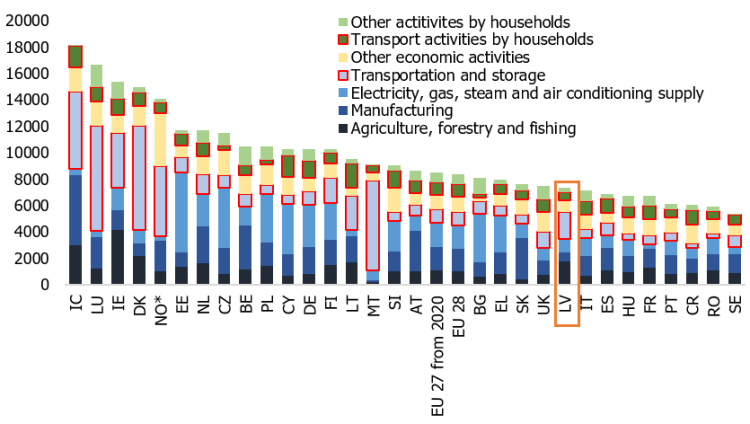
* Data for Norway refer to 2018.
Chart 1 shows that, looking by sector, the agricultural and transport sectors account for the highest volume of GHG emissions per capita in Latvia (the energy and manufacturing sectors are also among the largest sources of GHG emissions in some countries). In fact, the contribution from the transport sector is not a minor one, e.g. in Norway which stands out in Europe by its high electromobility level at least in the area of passenger cars. Moreover, mining generates significant volumes of emissions in the above country (constitutes the major part of "other sectors" reflected in the chart).
Second, growth in people's income and appreciation of comfort offered by cars suggest that the number of cars follows an upward trend over time (see Chart 2). Needless to say that such a situation adds to the need for an appropriate infrastructure – roads, parking lots and petrol stations. This requires investment, construction and land areas, which thereby become unsuitable both for human habitation and landscaping.
Chart 2. Number of cars per 1000 inhabitants in the EU countries, the United Kingdom, Iceland, Liechtenstein, Norway and Switzerland
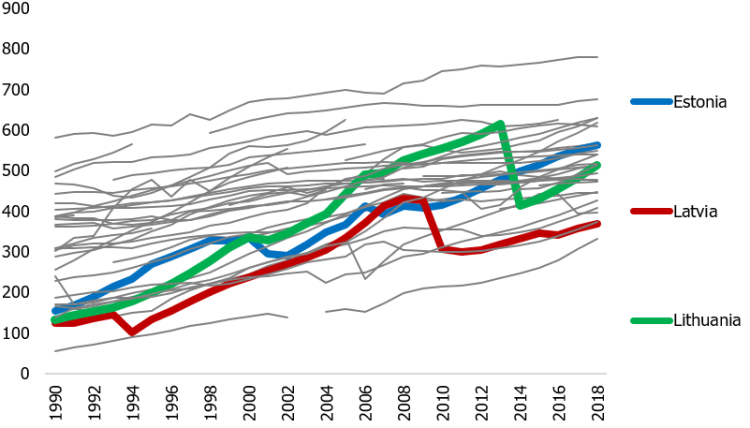
Of course, the charts show that the total volume of GHG emissions per capita in Latvia is among the most modest levels in the European countries at issue. Moreover, the number of vehicles is relatively small in Latvia. Income would play a significant role in this regard, affecting households' affordability of a particular vehicle type. Chart 3 shows that Latvia ranks among the EU countries with the oldest vehicle fleet [5]. This fact is often invoked as a reason for the large volume of emissions from transport in Latvia.
Chart 3. Share of cars above 10 years of age and the income level in the EU countries
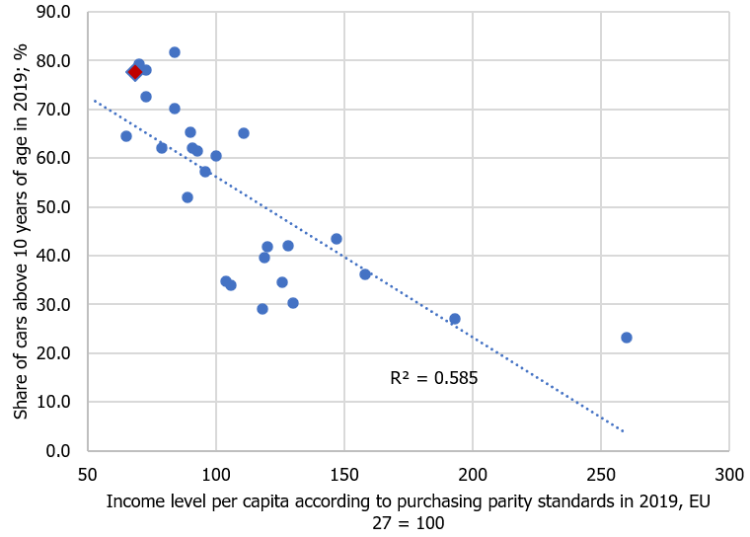
It would not be hard (nonetheless somewhat tendentiously) to use the first three charts to conclude that Latvia is a catching-up economy: the income level is low, the number of vehicles is small and the overall volume of GHG emissions is not that high. In this context, the fact that greening objectives apply to everybody simply reminds of the drawbacks of making comparisons, i.e. when you are "catching up" with countries with higher living standards and a great deal has yet to be achieved, it is not always easy to wish to see growth prospects decoupled from consumption of physical and material resources. At the same time, Latvia compared to other EU countries produces less value added per comparable amounts of GHG emissions (see Chart 4), particularly in the transport and agricultural sectors.
Chart 4. The volume of GHG emissions relative to the value added in European countries in 2019 (thousands of tons per 1 million euro)
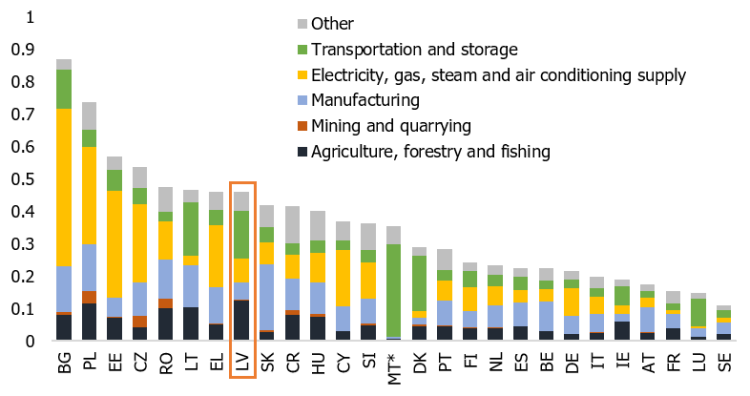
* The value added in the mining and energy sectors of Malta has not been presented separately.
Does a green car equal sufficient efforts?
When focusing specifically on transport activities, it is obvious that Latvia has moved slightly closer to some countries in which air and water transport has a more important role in the economy (see Chart 5). A closer look at the transport sector reveals the heavyweight of Latvia – land transport. This is no surprise, since, for example, only part of rail transport has been electrified and most of the trucks registered by the Road Traffic Safety Department are diesel-powered. Meanwhile, the volume of GHG emissions generated by Latvian household transport activities is one of the smallest among European countries.
Chart 5. The volume of GHG emissions generated by activities of the transport and storage sectors as well as households (kg per capita)
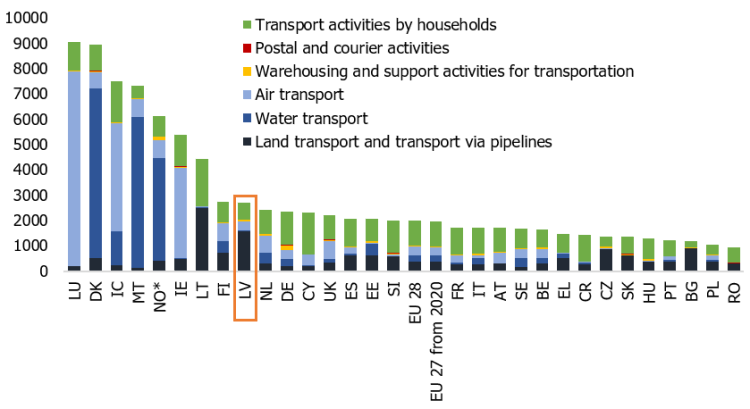
* Data for Norway refer to 2018.
Let us try to describe an average owner/driver of an electric car in Latvia. Could he/she be at least a middle-class, hasty business person living in one of the largest cities or in their proximity? Possibly, yes. Is he/she an average inhabitant of Latvia? I doubt it.
What suggests that the person described above could be a real one? The Road Traffic Safety Department data indicate that despite the soaring number of electric car registration in Latvia, the recent years have seen the share of cars fitted with a diesel engine increase rapidly (by 27 percentage points in the passenger car group; see Chart 6). Yes, this could be related to the low income level. However, overall, the EU countries demonstrate that the carrot and stick or the motivation and prohibition/inconvenience mechanism is no less important. This mechanism makes it irrational or even impossible to use a diesel passenger car.
Chart 6. The share of vehicles fitted with diesel and electric engines registered in Latvia (%)
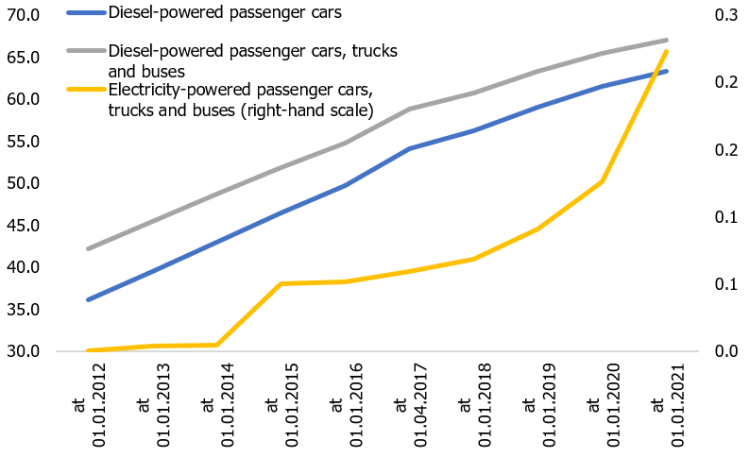
Data of the European Automobile Manufacturers Association [6] also show that Latvia, as a country with the lowest share of electric cars in the total population's car fleet, ranks among the EU countries with no major purchase initiatives or support equivalent to subsidies encouraging electric car purchases. At the same time, Latvia is among the three countries where the number of fast charging points exceeds [7] that of the "normal" ones (2.7 times). Moreover, Latvia, as a member of the group of the EU and the United Kingdom, outperforms its counterparts significantly in this regard. This figure can probably be explained by the fact that the era of electric cars in Latvia started later than in other countries, but it might as well be explained by the above description of a driver. Such a driver also benefits from an opportunity to park his/her electric car in certain parking lots free of charge (an acute problem in the centre of Riga) as well as enjoys the privilege of using a public transport lane (not a problem outside large cities).
Considering the use of the carrot and stick mechanism in any area shows attempts to achieve something by going against the stream. This is the first signal indicating that this stream does not carry us in the desired direction. In other words, something is wrong with the way society functions on its own. As we have seen, Latvia can offer a rather small sack of carrots for facilitating electromobility, and at the same time the electrification of a large polluter has come to a standstill due to the project's insufficient effectiveness.
The change of the vehicle fleet, the establishment of an appropriate charging infrastructure and the production of the needed energy entail substantial investment and even environmental changes (from a possible replacement of a couple of lilac bushes in a courtyard of a residential building by charging points to constructions obstructing the view of the sun or sea, – one of the reasons behind ruining some renewable energy production projects).
To replace the present fleet of passenger cars with electric ones, Latvia would need funds totalling approximately the amount of 18-month-long aggregate private consumption.
Playing around with some calculations, e.g. using the data on excise tax revenues provided by the State Revenue Service [8], we come to the conclusion that the money people in Latvia spend on cigarettes and tobacco a year would buy 7000–8000 decent electric cars, and this number would exceed by far that of the electric cars registered to date. This would, however, make a large number of drivers share one car in their day-to-day lives (according to the data of the Centre for Prevention and Control of Diseases [9], one quarter of the population aged 15 years and older smoked on a regular basis in 2018). Greening the transport sector is unlikely to take place in ceteris paribus conditions, i.e. keeping all other things equal. The new cars will likely still be equipped with more up-to-date gadgets, autonomous control, etc. not to mention the development of other types of consumption. The shift towards a circular economy would certainly make people use the purchased things for a longer period of time. However, this will be difficult if, e.g. a car becomes less trendy and non-environmentally friendly too quickly or its use is incompatible with smarter solutions. The relevance of comprehensive consideration of consumption habits (including the volume of consumption) will not follow a downward path even when complete electromobility is achieved.
Summary
The transport sector is a significant source of GHG emissions both in Latvia and in a number of other European countries. They are often countries with a very significant share of air and water transport traffic, and these two segments of the transportation industry might not witness reliable and economically feasible solutions emerging over the next few years. Meanwhile, the contribution of household transport to total GHG emissions is relatively small, i.e. the overall benefits from greener practices would be rather limited even if people were deprived of their cars right away and forever. In the absence of significant large-scale electrification projects, it can turn out to be difficult to achieve zero net GHG emissions, and possibly we will have to sway the balance between economic advantage and emission-free practices at some point in time.
As long as there is no carrot encouraging people of Latvia to buy an electric car, and little progress is achieved in electrification of the rail and road transport (not to mention air transport), with a consumer neither benefiting from nor contributing to such projects (at least during their development phase and the long implementation period), all of us can probably develop other daily habits of greener living and put them into practice in a quicker and more efficient manner.
References
[1] See, e.g. https://eur-lex.europa.eu/legal-content/LV/TXT/PDF/?uri=CELEX:52020PC0080&from=EN; EUR-Lex - 52019DC0640 - EN - EUR-Lex (europa.eu); https://eur-lex.europa.eu/legal-content/LV/TXT/HTML/?uri=CELEX:52020DC0098&from=EN; Fundamental transformation of transport: The Commission presents a green, smart and affordable mobility plan; On the action plan for the transition to a circular economy 2020–2027, etc.
[2] See Air pollution (who.int).
[3] See Public health and environment (who.int).
[4] Electric road vehicles in the European Union (europa.eu)
[5] For example, Ar nodokli vecāku automašīnu iegādei Latvijā plāno veicināt autoparka atjaunināšanu/ Raksts/LSM.lv.
[6] https://www.acea.be/uploads/publications/Electric_vehicles-Tax_benefits_purchase_incentives_European_Union_2020.pdf.
[7] https://www.acea.be/uploads/publications/ACEA_progress_report_2020.pdf, p. 22.
[8] https://www.vid.gov.lv/lv/vid-administretie-kopbudzeta-ienemumi-2020gada-986-miljardi-eiro.
[9] https://www.spkc.gov.lv/lv/zinojumi/tematiskais-zinojums-smekesanas-izplatiba-un-sekas-latvija-2018.gada-7.-izdevums.pdf
Textual error
«… …»


